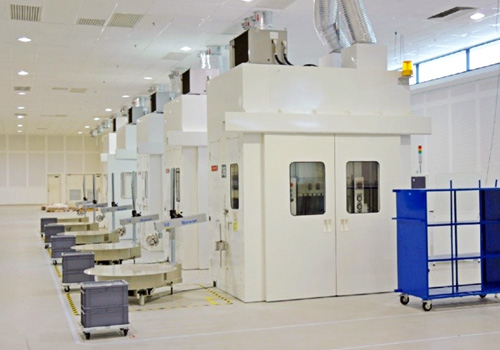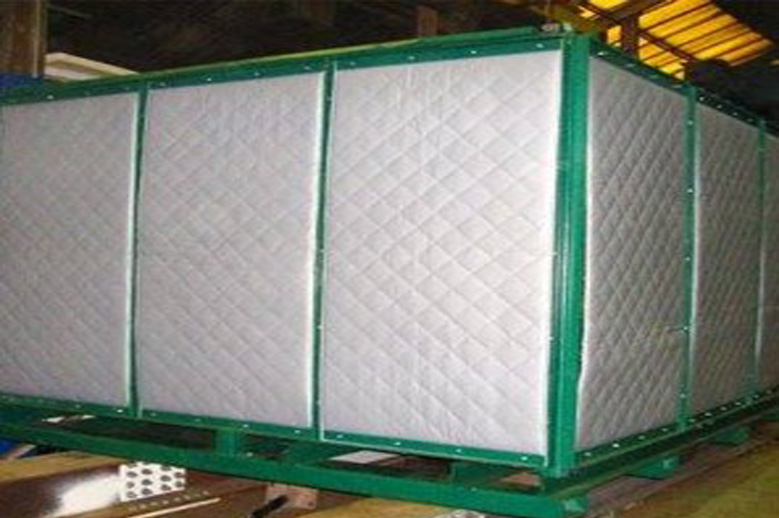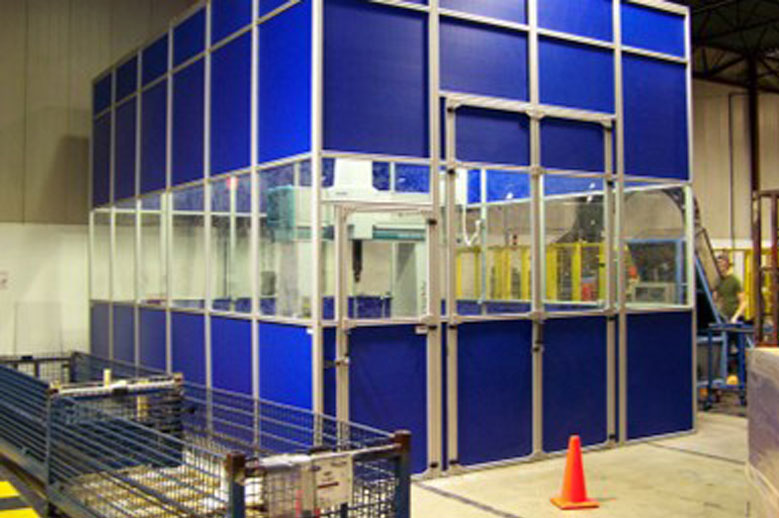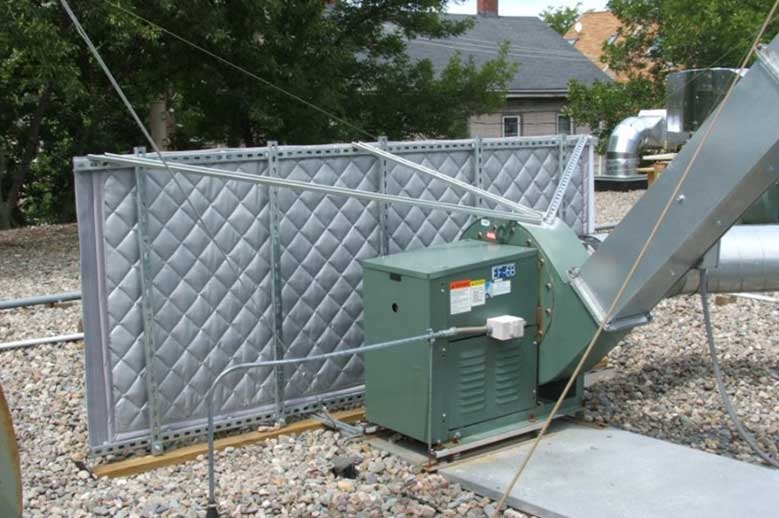Noise Isolation Enclosures for Industrial Applications
MEMTECH ACOUSTICAL is a well-established designer and supplier of acoustic enclosures.

Industrial Noise Enclosures
A well-established designer and supplier of noise isolation and acoustic enclosures.
 Noise enclosures are used for many purposes, including the reduction of noise from machinery, isolation of workers in high-noise environments or for end-of-line validation testing.
Noise enclosures are used for many purposes, including the reduction of noise from machinery, isolation of workers in high-noise environments or for end-of-line validation testing.
Examples of typical noise enclosure applications include:
- Ventilation equipment
- Transformers
- Pumps
- Compressors
- Metal machining equipment such as broaches, milling operations or grinders
- Creating a ‘quiet zone’ for workers or testing in loud environments.
Enclosures can easily be configured for indoor/outdoor use, and are available with windows (including impact-resistant glass), doors, maintenance access ports, and numerous other features.
Effective acoustic enclosures are not simply ‘boxes’, but must be selected based on the amplitude and frequency content of the noise source(s), as well as the desired degree of acoustic isolation. For example, if an 80 dBA goal is established for an ambient (external) noise level, a machine producing 110 dBA with dominant frequencies below 50O Hz. will usually require the use of a high-mass constrained-layer enclosure wall design. However, if the dominant frequencies are much higher, a less complex enclosure will be adequate.
MEMTECH ACOUSTICAL can quantify the noise levels of your equipment and provide the most cost-effective options to meet your goals.
Here are some key features and considerations regarding industrial noise enclosures:
Soundproofing Materials: Industrial noise enclosures are constructed using materials with high sound absorption, insulation or isolation properties. Common materials used include mass-loaded vinyl, acoustic foam, fiberglass, perforated metal panels, and composite materials. These materials help reduce noise transmission through absorption and blocking of sound waves.
Structural Design: The enclosure structure is designed to be rigid and airtight to prevent sound leakage. It may consist of panels or modular sections that can be easily assembled and disassembled for maintenance or reconfiguration purposes. The structure should be robust enough to withstand the vibrations eliminate the ‘s’ and noise generated by the enclosed equipment.
Ventilation and Cooling: Industrial machinery often generates heat, so proper ventilation and cooling considerations must be considered. Ventilation systems with noise-reducing features, such as acoustic louvers or silencers, can be incorporated into the enclosure design to maintain adequate airflow and equipment cooling while minimizing noise leakage.
Access Points: Noise enclosures should provide convenient access points for maintenance, repairs, and equipment operation. These access points may include hinged or removable panels, doors, or windows designed with acoustic seals to maintain noise containment when closed.
Compliance with Regulations: Industrial noise enclosures must comply with applicable regulations and standards regarding noise control and worker safety, such as those set by OSHA (Occupational Safety and Health Administration) or local authorities. It’s important to ensure that the design and construction of the enclosures meet or exceed these requirements.
Customization: Industrial noise enclosures are often customized based on the specific machinery, equipment, or processes they are intended to enclose. Factors such as the size, shape, and noise characteristics of the equipment must be considered to design an effective and efficient enclosure.
Questions to consider before selecting an acoustic enclosure:
- What is the desired noise reduction level?
- Is portability an important consideration?
- What are the dominant frequencies of the noise?
- What is the required cutoff frequency?
- Are internal reflections important? (e.g. for a noise test chamber located in a high-noise production facility, noise reflections inside the chamber may impact measurement accuracy)
- Is the enclosure intended for interior or exterior use?
- Is heat management (e.g. airflow) a consideration?
- Lighting and ventilation requirements for personnel inside the enclosure?
- Footprint (size) restrictions
- Are doors or maintenance portals required?
- Is the environment severe (e.g. casting plants, refineries, etc?)
Memtech Acoustical designs and builds noise enclosures for many applications and for all types of production equipment. A wide variety of products are available, depending on your specific needs and budget. All enclosures are custom engineered based on source sound levels, frequency content, heat management requirements and portability needs as noted above.

Modular Curtain Enclosures
Modular curtain noise enclosures are a type of noise control solution that provides a versatile and customizable approach to reducing noise in industrial environments. These enclosures consist of flexible curtain panels made from sound-absorbing and noise-blocking materials.
Here are some key features and considerations regarding modular curtain noise enclosures:
Construction: Modular curtain noise enclosures are typically constructed using durable and fire-resistant materials, such as vinyl, PVC-coated fabric, or composite materials. These materials are selected for their sound-absorbing properties to reduce noise levels and can be customized based on specific noise control requirements.
Flexibility and Modularity: The modular design of curtain enclosures allows for easy installation, modification, and reconfiguration. The curtain panels are often suspended from overhead tracks or mounted on frames, allowing for quick assembly and disassembly as needed. This flexibility makes them suitable for environments where equipment or layout changes are frequent.
Noise Reduction: Curtain panels are designed to absorb and block noise. They typically incorporate sound-absorbing materials on the surface facing the noise source, which helps reduce sound reflection and reverberation. Additionally, the curtain material itself provides some level of noise blocking by impeding the transmission of sound waves.
Customization: Modular curtain noise enclosures can be tailored to fit specific equipment or areas within an industrial facility. They can be manufactured in various sizes and shapes to enclose machinery, workstations, or designated noise-sensitive areas. The curtains can also be customized with additional features like transparent windows for visibility or access points for equipment maintenance.
Versatility: These enclosures are adaptable and can be used in diverse industrial settings, including manufacturing plants, machinery enclosures, welding areas, compressor stations, and more. They can be installed as standalone noise control measures or used in conjunction with other noise control solutions.
Safety Considerations: When using modular curtain noise enclosures, it is important to consider any potential safety hazards associated with the enclosed equipment. Adequate ventilation and cooling systems must be implemented to prevent overheating. Fire safety measures, such as fire-resistant materials and proper clearance from heat sources, can also be incorporated.
Modular curtain noise enclosures offer an efficient and cost-effective solution for controlling noise in industrial settings. However, their effectiveness may vary depending on the specific noise sources and the desired level of noise reduction. Modular curtain enclosures can be configured in a variety of ways, and provide good noise reduction capabilities. They are also economical and easy to maintain, and are well suited for interior or exterior use.
These curtains are usually hung from metal framework, and are sealed together via a very strong industrial Velcro product. Performance is typically limited to approximately 20 dBA of attenuation depending on application; however, the use of less flexible composite curtains can increase this performance significantly. A number of different products are available to suit any need.

Permanent Hard-Sided Enclosures
Hard-sided permanent noise enclosures are structures specifically designed to provide long-term noise control in industrial or commercial settings. Unlike modular or flexible curtain enclosures, these enclosures are constructed with rigid materials and are intended to be a permanent solution for noise reduction.
Here are some key features and considerations regarding hard-sided permanent noise enclosures:
Rigid Construction: These enclosures are typically built using rigid materials such as steel, concrete, or composite panels. The choice of materials depends on factors such as the level of noise reduction required, the size of the enclosure, and the specific application.
Soundproofing Materials: Within the enclosure, soundproofing materials such as acoustic foam, mass-loaded vinyl, or fiberglass insulation may be used to further absorb sound waves. These materials help reduce noise transmission and improve the acoustic performance of the enclosure.
Structure and Design: The design of a hard-sided noise enclosure takes into account factors such as structural integrity, air handling, ventilation, access points, and equipment integration. The enclosure may include features such as reinforced doors, windows with acoustic seals, and vibration isolation to further enhance noise control.
Customization: Hard-sided permanent noise enclosures can be customized to accommodate specific equipment, machinery, or processes within an industrial or commercial facility. They can be designed to fit around existing structures or integrated into new construction projects.
Compliance with Regulations: Noise enclosures should comply with applicable regulations and standards, including those related to worker safety and environmental noise. It’s important to ensure that the design and construction of the enclosures meet or exceed the necessary requirements and guidelines.
Maintenance and Durability: Hard-sided enclosures are built to withstand the rigors of industrial or commercial environments. They should be designed for easy access, maintenance, and cleaning to ensure long-term durability and effectiveness in noise control.
Hard-sided permanent noise enclosures are commonly used in industries such as manufacturing, power generation, oil and gas, and transportation, where noise control is critical for worker safety, regulatory compliance, and community noise mitigation. They provide a robust and durable solution for long-term noise reduction in demanding environments. Airflow management and lighting can be included if personnel are working inside the chamber. Windows and doors are available. Interior walls can be configured to absorb reflected noise if desired. Attenuation of up to 70 dBA is achievable.

Portable Noise Baffles and Barriers
Portable noise curtains, also known as temporary or movable noise barriers, are flexible and versatile noise control solutions that can be easily installed, repositioned, or removed as needed. These curtains are designed to reduce noise transmission and provide temporary noise isolation in various environments.
Here are some key features and considerations regarding portable noise curtains:
Material: Portable noise curtains are typically made of durable, sound-absorbing materials such as mass-loaded vinyl, reinforced PVC, or composite materials. These materials are lightweight, flexible, and offer good acoustic properties.
Noise Reduction: Portable noise curtains are designed to absorb and block sound waves, reducing noise transmission and creating a barrier between the noise source and the surrounding environment. They can significantly reduce noise levels in areas where permanent noise control measures may not be feasible or necessary.
Portability and Flexibility: These curtains are designed to be easily transported, installed, and repositioned. They often come with hanging systems such as tracks, frames, or grommets that allow for quick and flexible installation in different locations or configurations.
Customization: Portable noise curtains can be customized to fit specific spaces and requirements. They can be tailored to different heights, widths, and shapes to provide optimal coverage and noise reduction in a particular area.
Easy Installation: The installation of portable noise curtains is typically straightforward and does not require extensive construction or modifications. They can be hung from existing structures, frames, or support systems, or they may come with freestanding options such as portable frames or stands.
Versatility: Portable noise curtains can be used in a wide range of applications, including construction sites, industrial facilities, temporary work areas, event venues, and commercial spaces. They can be used to create temporary enclosures, partitions, or perimeter barriers to contain noise and protect workers or minimize noise impact on nearby areas.
Durability and Maintenance: Quality portable noise curtains are designed to withstand wear and tear in demanding environments. They are resistant to moisture, UV exposure, and chemical exposure, making them suitable for both indoor and outdoor applications. Regular cleaning and maintenance are typically required to ensure their effectiveness over time.
Portable noise curtains offer a convenient and flexible solution for temporary noise control needs. They can be easily installed, repositioned, and removed, making them suitable for projects or situations where a permanent noise control solution is not required or feasible.
